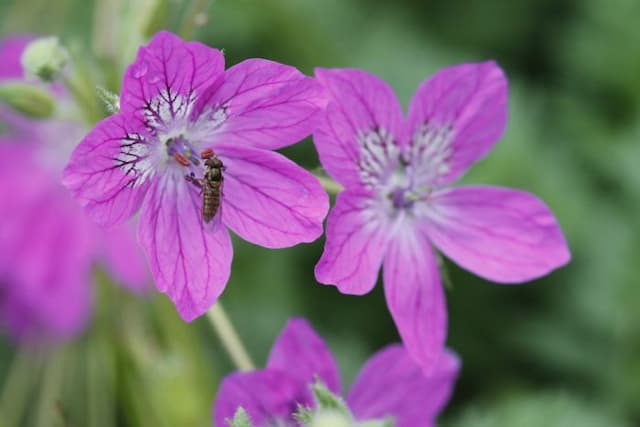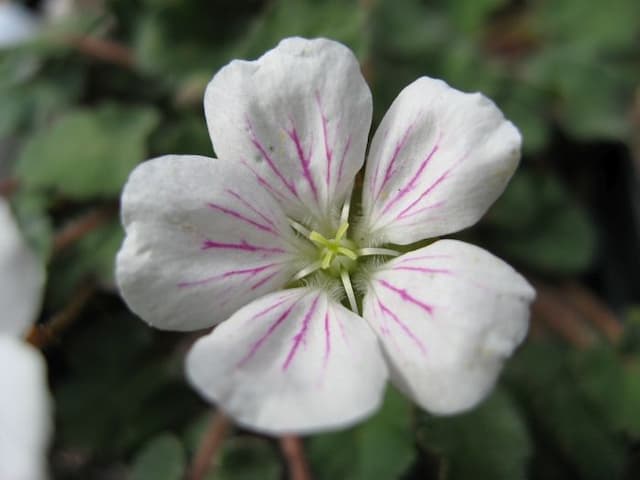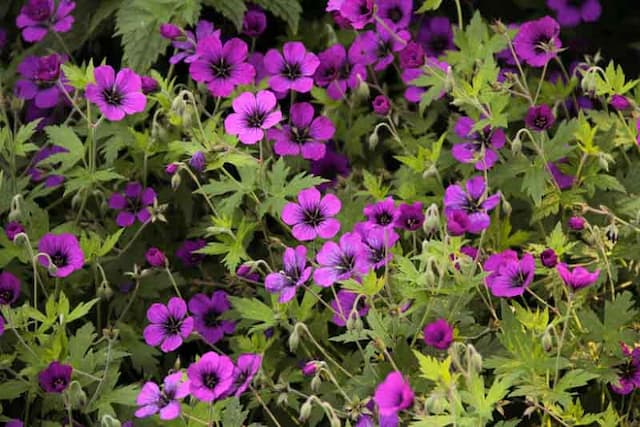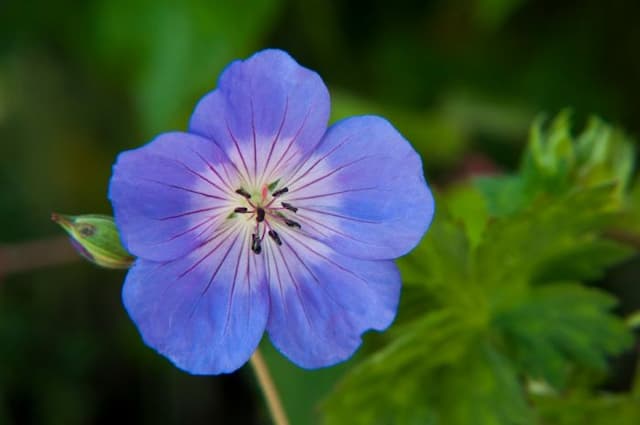Zonal Geranium Pelargonium 'Juve' (Z)

ABOUT
Pelargonium 'Juve' is commonly known as "Geranium", a name often associated with plants of the genus Pelargonium. Its appearance is characterized by lush, showy foliage and vibrant flowers that can be a focal point in any garden or pot. The leaves of the Geranium 'Juve' are typically rounded, with a soft texture and a somewhat scalloped or lobed edge. They may have a unique zonal pattern marked by a darker color, usually circular or horseshoe-like, which adds to their ornamental value. The flowers of the Geranium 'Juve' are one of its most striking features. They bloom in clusters, known as inflorescences, and can be found in a variety of colors including pinks, reds, purples, or whites. Each flower has five petals that are broadly rounded, with the upper two often being slightly larger or differently colored. This contrast can be quite eye-catching. Geranium 'Juve' is known for its continuous blooming throughout the growing season. The plant's overall shape is typically upright and bushy, with stems that can be both succulent and woody as the plant matures over time. This characteristic structure along with its bright and showy flowers makes it a popular selection for gardeners looking to add a splash of color to their outdoor or indoor spaces, without mentioning its specific dimensions.
About this plant
 Names
NamesFamily
Geraniaceae.
Synonyms
Zonal Geranium, Common Geranium, Garden Geranium.
Common names
Pelargonium 'Juve' (Z).
 Toxicity
ToxicityTo humans
Geraniums are not considered highly toxic to humans. However, ingestion can potentially cause minor symptoms such as an upset stomach, vomiting, or diarrhea. It is generally advised to keep plants away from children who might chew on them due to the risk of mild gastrointestinal discomfort.
To pets
Geraniums are known to be toxic to pets, especially dogs and cats. If pets ingest part of a geranium plant, they may experience symptoms such as vomiting, anorexia, depression, and dermatitis. In some cases, ingestion can lead to more severe reactions and it is recommended to contact a veterinarian if you suspect your pet has eaten any part of a geranium plant.
 Characteristics
CharacteristicsLife cycle
Perennials
Foliage type
Evergreen
Color of leaves
Green
Flower color
Mixed
Height
1-2 feet (30-60 cm)
Spread
1-2 feet (30-60 cm)
Plant type
Herb
Hardiness zones
10
Native area
South Africa
Benefits
 General Benefits
General Benefits- Aesthetic Appeal: Pelargonium 'Juve' (commonly known as Geranium) adds vibrant color and beauty to gardens and indoor spaces with its attractive flowers and foliage.
- Low Maintenance: Geraniums are relatively easy to care for, requiring minimal upkeep once established, making them ideal for busy gardeners or those new to gardening.
- Drought Tolerance: Once established, geraniums can tolerate periods of dryness, making them suitable for xeriscaping or regions with water restrictions.
- Pest Resistance: Geraniums are known to have some resistance to common garden pests, reducing the need for chemical pesticides.
- Long Blooming Season: Geraniums can bloom for extended periods, often from spring until frost, providing long-lasting color in the garden or home.
- Versatility in Landscaping: They can be used in a variety of settings, including flower beds, containers, hanging baskets, and window boxes, offering flexibility in garden design.
- Attracts Pollinators: Geraniums can attract beneficial insects such as bees and butterflies, contributing to the health of your garden’s ecosystem.
- Edible Uses: Some parts of certain geranium species are edible and used in culinary applications, such as flavoring desserts and drinks (though care must be taken to ensure the specific plant is safe for consumption).
- Easy Propagation: Geraniums are easily propagated from cuttings, allowing gardeners to create new plants from existing ones without the need for purchasing new plants.
 Medical Properties
Medical PropertiesThis plant is not used for medical purposes.
 Air-purifying Qualities
Air-purifying QualitiesThis plant is not specifically known for air purifying qualities.
 Other Uses
Other Uses- Pelargonium 'Juve', commonly known as Geranium, can be used as a natural dye for fabrics, giving a range of pink, orange, and red hues depending on the mordant used.
- Geranium leaves can be placed in cupboards or drawers to impart a pleasant scent to linens and deter moths and other insects.
- The flowers of Geraniums are edible and can be used to decorate salads or deserts, adding a splash of color and a mild citrus flavor.
- Geraniums can be planted in outdoor animal enclosures, such as chicken runs, to provide shade and possibly deter certain pests with their scent.
- The plant can be used in sensory gardens due to its aromatic leaves, which release their scent when touched, providing an interactive experience.
- Pressed Geranium leaves and flowers can be used in crafting, such as in homemade paper, bookmarks, or in botanical art pieces.
- The Geranium's essential oil can be utilized as a natural mosquito repellent when applied to surfaces or used in candle-making.
- Geraniums may be used as companion plants in the vegetable garden to help repel pests that would otherwise attack vegetables like tomatoes and peppers.
- Geranium extracts are sometimes used in homemade cleaning products for their scent and potential antibacterial properties.
- Geranium plants can be used in educational settings, such as schools or botanical workshops, to teach about plant propagation and horticulture.
Interesting Facts
 Feng Shui
Feng ShuiThe Geranium is not used in Feng Shui practice.
 Zodiac Sign Compitability
Zodiac Sign CompitabilityThe Geranium is not used in astrology practice.
 Plant Symbolism
Plant Symbolism- Comfort: Pelargoniums, commonly known as geraniums, are often associated with comfort due to their familiar, homey appearance in window boxes and gardens, symbolizing a source of solace and familiarity.
- Health: Geraniums have been used in traditional medicine, representing healing and the promotion of good health.
- Friendship: Offering a geranium plant can be seen as a gesture of friendship or a symbol of a strong bond between two people.
- Positive emotions: The bright and varied colors of geranium flowers are thought to evoke positivity, happiness, and good spirits.
- Sturdiness: Geraniums are known for their robust nature, signifying resilience and the ability to withstand challenges.
 Water
WaterGeraniums, including Pelargonium 'Juve', prefer to be watered deeply but infrequently. It's important to let the soil dry out between waterings, which typically means watering every 7 to 10 days, depending on the climate and the plant's environment. Use approximately 16 ounces of water for a standard 6-inch pot when you water, ensuring the water penetrates the soil well. During the growing season, in spring and summer, they may require more frequent watering, especially if they are in a hot, sunny location. In cooler months, reduce the frequency as the plant's water needs decrease.
 Light
LightGeraniums require plenty of bright, indirect light to thrive. The best spot for a Pelargonium 'Juve' is a location where it can receive about 6 hours of morning sunlight daily. Direct afternoon sun can sometimes be too intense and may cause leaf scorching. East or west-facing windows are typically the best indoor spots for geraniums, providing the balance of light they need.
 Temperature
TemperatureGeraniums grow best in temperatures between 65 and 75 degrees Fahrenheit during the day and no lower than 50 degrees Fahrenheit at night. They can survive temporary dips down to about 30 degrees Fahrenheit but frost can be damaging. The ideal temperature range to encourage blooming and healthy growth is maintaining a consistent environment where the temperature doesn’t fluctuate drastically.
 Pruning
PruningPrune geraniums to promote bushy growth, remove dead or dying foliage, and encourage more blooms. Cut back leggy stems and deadhead spent flowers regularly throughout the growing season to maintain the plant's shape and size. The best time to do a significant prune is in early spring or just after the plant has finished a bloom cycle. Snipping just above a leaf node will encourage the plant to produce more branches.
 Cleaning
CleaningAs needed
 Soil
SoilFor Geranium 'Juve' (Z), the best soil mix is light, well-draining potting soil that includes peat, perlite, and compost. It prefers slightly acidic to neutral pH, between 6.0 and 7.0.
 Repotting
RepottingGeraniums should be repotted annually, ideally in the spring, to refresh the soil and encourage healthy growth.
 Humidity & Misting
Humidity & MistingGeranium 'Juve' (Z) thrives in average household humidity levels, between 40-60%.
 Suitable locations
Suitable locationsIndoor
Place in bright, indirect light and water when soil feels dry.
Outdoor
Needs full sun to partial shade, well-draining soil, and moderate water.
Hardiness zone
10-11 USDA
 Life cycle
Life cycleThe life cycle of the Pelargonium 'Juve', commonly known as a Geranium, begins with seed germination, which takes place in a warm, moist soil environment. After sprouting, the seedling grows into a young plant with characteristic lobed leaves and begins to develop a sturdy stem. As it matures, the Geranium enters the vegetative stage, during which it continues to produce more leaves and branches, accumulating resources for flowering. When environmental conditions are favorable, typically in the spring or early summer, the plant enters the flowering stage and produces vibrant flowers in a range of colors from red to pink to white. After pollination, flowers will develop into fruit which contains seeds, completing the reproductive cycle. These seeds can then be dispersed to start new plants while the parent plant may continue to grow and undergo multiple flowering cycles within its perennial life span.
 Propogation
PropogationPropogation time
Spring-Summer
The most popular method of propagation for Pelargonium 'Juve', commonly known as a type of Geranium, is through stem cuttings. This is typically done in spring or early summer when the plant's growth is most active. To propagate, a gardener would take a healthy stem cutting about 4 to 6 inches (10 to 15 centimeters) long, ensuring that it includes at least three sets of leaves. The bottom leaves are removed, and the cut end may be dipped in a rooting hormone powder to encourage root development. The cutting is then planted in a pot filled with a well-draining soil mix, such as equal parts peat and perlite. The soil is kept moist but not waterlogged, and the cutting is placed in a warm spot with indirect sunlight. In a few weeks, the cutting should establish roots and can be transplanted if desired.







![Cranesbill [Rothbury Gem]](/_next/image?url=https%3A%2F%2Fplants-admin.emdemapps.com%2Fimages%2Fplants%2F%2Fimages%2F604b6243984c2.png&w=640&q=75)

